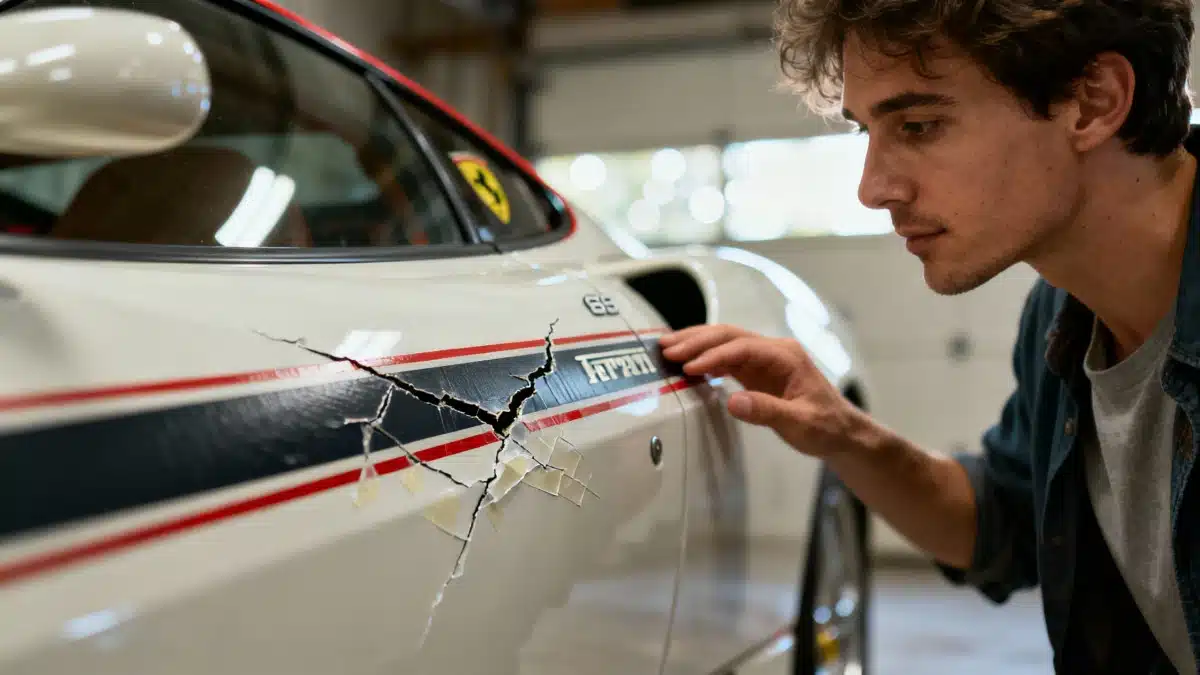The YouTuber Who Would Save Any Ferrari
If you’re into classic cars or spend any time down the rabbit hole of YouTube, you probably know Ratarossa—the British Ferrari enthusiast with a knack for bringing back models most mortals would happily send to the scrap heap. For over fifteen years, his weekends, his nights, and a decent chunk of his savings have gone into rescuing legendary cars: 308, 328, 512 BB, 360 Modena… You name it, he’s probably dreamt of fixing it. One wish still eludes him—a restoration-worthy Ferrari F40. The Holy Grail of the Maranello faithful.
This time, though, it wasn’t a barn find or a sunken wreck giving him headaches. It was his trusty Ferrari 360 Modena—the one he drives almost daily. After nine months of meticulous restoration (think: full teardown, respray, fresh interior, refurbished brakes, restored engine bay—the works!), the car gleamed, ready to conquer the road again. Flawless, or so he thought… until a humble vinyl stripe shattered that illusion.
When a Stripe Becomes a Disaster
On the jet-black body of his 360, Ratarossa had a tricolor stripe installed. Inspired by Ferrari’s Challenge Stradale, it’s the kind of detail you’d recognize from Italian sports models and racing specials. For a few glorious weeks, all seemed perfect. Then came a little blemish… then another. In no time, the immaculate line morphed into a parade of ridges and razor-sharp cracks, as if someone had taken a scalpel—right to his dreams.
“It’s a nightmare,” he admits in his video. “We spent nine months making the car perfect, and now the vinyl stripe is shrinking every day.”
The verdict was swift and brutal: the vinyl had shrunk, leaving behind a visible ridge under the clear coat. Worse, the first defects crept from the hood toward the roof. The only way to fix it properly? Sanding and repainting nearly two-thirds of the car. Ouch.
Unmasking the Culprit: Vinyl Choices Matter
After airing his troubles on YouTube, a seasoned professional with forty years’ experience in vinyl films offered his take. The problem: the stripe had been printed on calendered vinyl—a lower-grade material—rather than high-performance cast vinyl. On a black car, parked in the sun, that’s a recipe for disaster.
Calendered vinyl just can’t handle wild temperature swings. A black body soaks up the heat, so the material expands, contracts, and eventually starts peeling off under the clear coat. The expert gave it straight:
“On a black car, vinyl gets extremely hot in the sun. I’ve seen stripes shrink by over 20 mm!”
His suggested cure? Repaint the hood, then apply a new stripe in cast—or “molded”—vinyl, but don’t bury it under a clear coat this time. Lesson learned the hard way, perhaps, but at least it’s fixable. In theory.
More Than Just a Stripe: The Subtle Flaws of Restoration
The nightmares didn’t end with the stripe. Ratarossa also spotted a slew of clear coat issues elsewhere on the car—doors, fenders, spots where no vinyl ever touched. We’re talking streaks, dry patches, tiny bubbles. Not the vinyl’s fault, it turns out, but more likely linked to the painting process: chilly weather, uneven drying, or maybe a heavy-handed layer of clear coat.
In short:
- The vinyl stripe explains the disaster on the hood and roof.
- The other flaws largely stem from classic paintwork hiccups—fixable only by repainting. Joy.
Ratarossa, understandably deflated, admits the repair will take both time and money:
“I’m not a perfectionist, but when my ten-year-old daughter asks what those marks are on the car, I know they’re a bit too obvious.”
Still, he keeps his spirits—and sense of humor—intact: the V8 engine purrs beautifully, the brakes are sharp, the interior is stunning. Maybe, one day, he’ll redo the paint properly—or go for something totally wild, like metallic purple. (Don’t tempt him!)
The Perils (and Pitfalls) of Perfect Restorations
As in so many tales from Ratarossa’s garage, this story probably isn’t over. If nothing else, it’s a textbook case of how even the tiniest details can undo months of patient work. In the restoration world, perfection is elusive—and sometimes, even a humble vinyl stripe can teach you that lesson the hard way.
Some readers might remember similar woes in the U.S. back in the 1980s, when car manufacturers switched primer formulas and wound up with incompatible paint. You could spot cars from that era on the roads, missing huge swaths of paint—a paint-by-era, if you like.
And if you’ve binge-watched American car shows, you’ll know there are always two ways to add stripes: adhesive vinyl or painted. The latter is slower, trickier, more expensive—but the results last. Sure, a careless touch with the spray gun, and you risk streaks on your prized restoration—never mind trying to paint that center stripe just right.
Best practice? Stripes go on after the color layer but before the clear coat, baking together to prevent later shrinking or cracking. Anything added after delivery only gets a warranty if an approved technician uses the manufacturer’s own materials. As for automotive vinyl, it’s packed with saturated polymers, has less cellulose, making it tougher, more hydrophobic, and less temperature-sensitive—though you still have to watch for yellowing in sunlight (thankfully, UV additives exist). Factory clear coat usually keeps stripes safe from the elements.
And as for our endlessly likeable YouTuber: what a noble mission, hunting down Ferraris to restore, preserving Maranello’s living heritage one car at a time. As for that elusive F40 project—well, some dreams might always be just out of reach.

John is a curious mind who loves to write about diverse topics. Passionate about sharing his thoughts and perspectives, he enjoys sparking conversations and encouraging discovery. For him, every subject is an invitation to discuss and learn.






